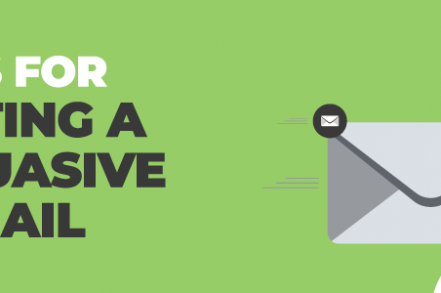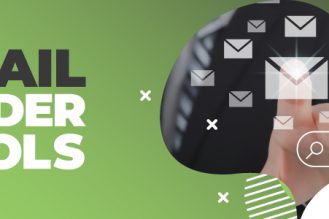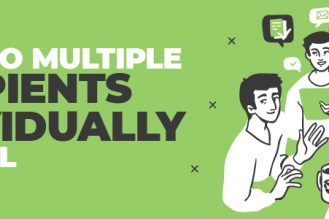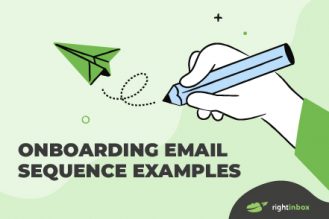I attended a conference last year where a speaker sharing productivity tips recommended blocking off time in our calendar to dedicate to our inboxes. “Your whole job isn’t to send emails,” she reasoned, “so you shouldn’t spend your whole day doing it.”
So much of our jobs in marketing or sales, though, is sending emails.
I didn’t start blocking off dedicated email time after the conference, but I did start paying attention to how effective I was while I was in my inbox answering or sending emails. It made me realize that so many of the emails I wrote or received weren’t compelling or didn’t prompt an action. And now, when we’re all receiving so many emails on a daily basis, it’s important to stand out with well-written, persuasive emails.
What is a Persuasive Email?
A persuasive email is basically a message that’s trying to convince the recipient to do something or see things a certain way. It’s written in a way that’s easy to understand and uses persuasive language, which might even be customized to the person you’re emailing. Sometimes it uses social proof or creates a sense of urgency to really drive the point home.
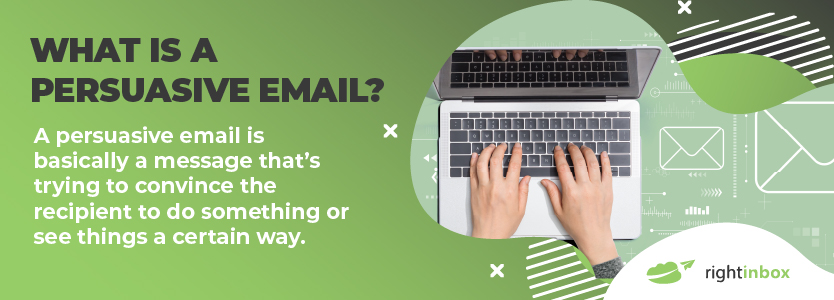
What to Include In a Persuasive Email
When writing a persuasive email, there are a few key elements you should include to ensure your message lands with your reader:
- A clear and concise subject line that grabs the recipient’s attention
- An introduction that establishes rapport and builds trust
- A clear statement of purpose that highlights the benefits for the recipient
- Evidence to support your claims, such as data, testimonials, or examples
- A call to action that is specific and easy to follow
- A friendly and professional tone that shows respect for the recipient
Remember, the goal is to persuade, not manipulate or coerce. Keep your message honest, respectful, and focused on the recipient’s needs and interests.
Here are six tips for writing better, more persuasive emails:
- Start with the subject line
- Leverage the curiosity gap
- Stick to your purpose
- Speak to your target audience
- Avoid mistakes with templates
- Use persuasive language
1. Start with the Subject Line
Your subject line is always the most important opportunity to persuade your audience in email marketing—you need the recipient to open the message in order to persuade them any further. So start by making your subject line engaging.
Consider these subject lines from my own inbox:

The subject lines from Old Navy and Shutterfly contain lots of good information about the value of the email, but the length and the dull language makes them easy to skim over. They look so similar to all the other sales emails that I receive.
The subject lines from MiniLuxe and Crate and Barrel, on the other hand, stand out. The MiniLuxe subject line is eye-catching with the use of emoji and, then, with the rhyme. I have no idea what the glow could be—or, honestly, if I’d pay for it—but I’m intrigued. Crate and Barrel’s subject line is more straightforward, and this is what stands out. The simple “ENDS TONIGHT” evokes urgency, and, again, I want to know what’s on sale.
It might not be a coincidence that the best subject lines here are short. When researching effective subject lines, Marketo found that subject lines that are four to seven words long performed best.

So stick to a low word count and start persuading your audience with some intrigue in your email subject line.
2. Leverage the Curiosity Gap
Both of those subject lines were successful in part because they leveraged the curiosity gap, and you can use this for more persuasive email copy, too.
The curiosity gap is the difference between what we know and what we want to know, and we’re naturally motivated to resolve that difference when we learn that new information is available. To leverage this effectively in your copy, you need to let your audience know that new information is available.
One way to do this is to pose questions that you’ll answer in your offer, whether it’s a webinar, a content download, or a product demo. Here’s an example from HubSpot:
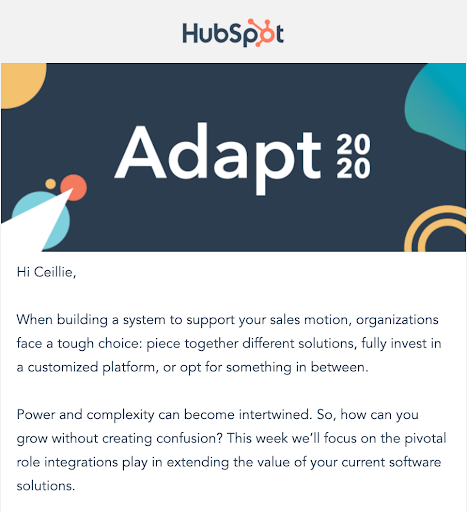
The email presents a problem, choosing a sales system, and then poses a question, “So, how can you grow without creating confusion?” The audience will want an answer to this, which motivates them to convert and sign up for the webinar offer.
3. Stick to your Purpose
Each of your emails should have a specific purpose. In order to persuade someone, you need to know what you want them to do and why. One way to better understand your audience is by creating a customer or buyer persona.
If we consider your email as a rhetorical situation, we can look at the breakdown of key components: the sender (writer), the context, the message, the purpose, and the audience. We’ll talk more about the audience and the messaging in the next few tips. For now, let’s talk about defining the purpose of your email.
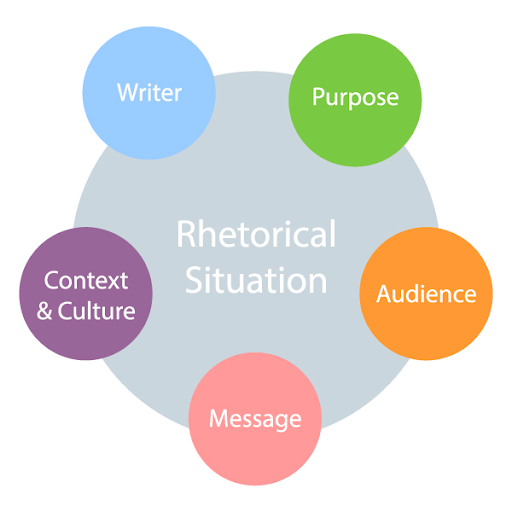
To define your purpose, think about what you want to accomplish in your email. Promote a webinar. Offer a content download. Announce a product release. Share your first blog post. These are all great options for the purpose of a marketing email. Once you determine the purpose, you need to stick to that to write a specific, persuasive email.
4. Speak to your Target Audience
In order to persuade anyone, you need to know who you’re talking to. This is key in most marketing, and it’s especially important in email. Even though you’re often marketing one-to-many, email still offers the opportunity for more personalization and more one-to-one messaging than other marketing channels.
Here are a few ways you can speak directly to your target audience for more persuasive emails:
- Use buyer personas. If you have good personas, you can speak to your audience’s motivations and frustrations. This helps make the email copy more personalized, and more compelling.
- Segment your lists. Getting specific in your segmentation lets you speak more directly to your audience. If you can focus on a single business type or one area at a time, try doing that and monitoring your results.
- Personalize your email copy. This can be as simple as using a first name, but even simple can be effective.
Above all, though, make sure the focus is on your audience rather than you or your business—that will help keep your email engaging rather than informational.
5. Avoid Mistakes with Templates
I’ve said it before: editing is important. Clean, error-free copy establishes your authority as a resource. Plus, when a reader notices typos or mistakes, they stop reading. Even if it’s just for a moment, it’s still a break in that connection. And when you’re trying to persuade someone over email, you can’t afford that break.
At the same time, when you’re sending lots of emails all day long, proofreading every single message can be tedious and time-consuming. That’s where templates can help you.
If your emails are anything like mine, there are a few standard types that you send over and over again with some slight variations. Instead of writing these from scratch and then proofreading every single email, you can use a tool like Right Inbox to set up email templates.
Just be sure you proofread your templates and make sure there are no mistakes in there.
6. Use persuasive language
Now, the messaging of your email. If you’re looking to excite your audience, use exciting language. If you’re looking to engage your audience, use engaging language. See where I’m going here? If you’re looking to persuade your audience, you need to use persuasive language.
Persuasive language often appeals to emotion, emphasizes urgency, and stresses value. Words like “new,” “instantly,” and “free” make lists of persuasive words for marketing. These not only create a sense of urgency but also address objections like wait time and cost.
I saved this email below from Privy because I loved the playful tone and the persuasive language.
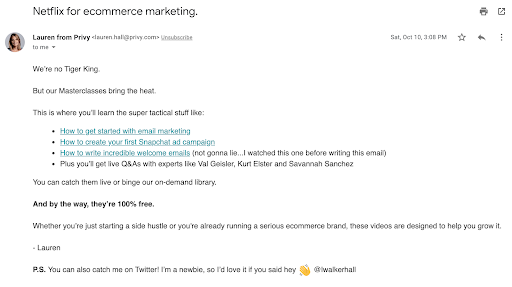
This email uses references to Netflix to introduce ecommerce course material, and the playful tone continues throughout with phrases like “bring the heat” and “super tactical.” Plus, it ends with a final persuasive reminder in bold: the resources are completely free.
5 Persuasive Email Templates (+ Examples)
“The Urgent Request” Template
Subject Line: Time-sensitive request
Dear [Name],
I hope this email finds you well. I have an urgent request. [Explain why the matter is time-sensitive and how responding quickly will benefit them].
I know this is a big ask, but I truly believe it’s worth your time and effort.
Thank you for your consideration.
Best regards,
[Your name]
This email uses urgency to persuade the recipient to take immediate action. It explains why the matter is time-sensitive and how responding quickly will benefit them.
“The Social Proof” Template
Subject Line: See how 100 others have already [benefited]
Dear [Name],
Have you ever wondered what it’s like to [desired action]?
Many people like you have already experienced the benefits of [desired action], and I think you would too.
[Use a testimonial or case study to show how others have benefited from taking the desired action].
If you’re interested in learning more, just reply “YES”. I’m happy to answer any questions you might have.
Best regards,
[Your name]
This uses testimonials or case studies to show how others have benefited from your product or service. This can help build credibility and trust, even if the subscriber is new to you.
“The Exclusive Offer” Template
Subject Line: Limited-time offer just for [name]
Dear [Name],
I hope this email finds you well. I wanted to reach out and share an exclusive offer with you.
For a limited time, [offer a discount or incentive to encourage the recipient to take action]. This offer is only available to you, so don’t miss out!
If you’re interested in taking advantage of this offer, please [include a clear call to action].
Best regards,
[Your name]
This persuasive template offers a limited-time discount or incentive to encourage the recipient to take action. It makes it clear that this offer is only available to them, so it feels more personalized.
“The Shared Goal”
Subject Line: Join us in achieving [goal]
Dear [Name],
I hope this email finds you well.
I wanted to reach out and see if you would be interested in joining us in achieving [shared goal]. We believe that [taking the desired action] is a critical step in reaching our goal, and we would love to have your support.
If you’re interested in learning more about how you can get involved, please [include a clear call to action].
Best regards,
[Your name]
This appeals to the prospect’s shared interests or goals to demonstrate why taking the desired action is important. This can create a sense of collaboration and cooperation.
“The Pain Point” Template
Subject Line: Don’t suffer any longer
Dear [Name],Are you tired of [pain point]? We understand how frustrating it can be to deal with [pain point], which is why we want to offer you a solution.
By [taking the desired action], you can [explain how taking the desired action can solve the problem].
If you’re interested in learning more about how we can help, please [include a clear call to action].
Best regards,
[Your name]
Simply put, this email addresses a specific pain point or problem that the recipient is facing and explains how taking the desired action can solve it. It uses empathy to connect with the recipient and show that you understand their challenges.
In Summary
With billions of emails sent each day, it’s important to make your emails as efficient and effective as possible. In most cases, that means writing persuasive emails that encourage clear, direct actions from your audience—so that you can spend more time getting work done and less time in your inbox.
Track emails, email reminders & templates in Gmail for free
Upgrade Gmail with the features it’s missing
Add to GmailDavid Campbell
David Campbell is the editor of the Right Inbox blog. He is passionate about email productivity and getting more done in less time.
